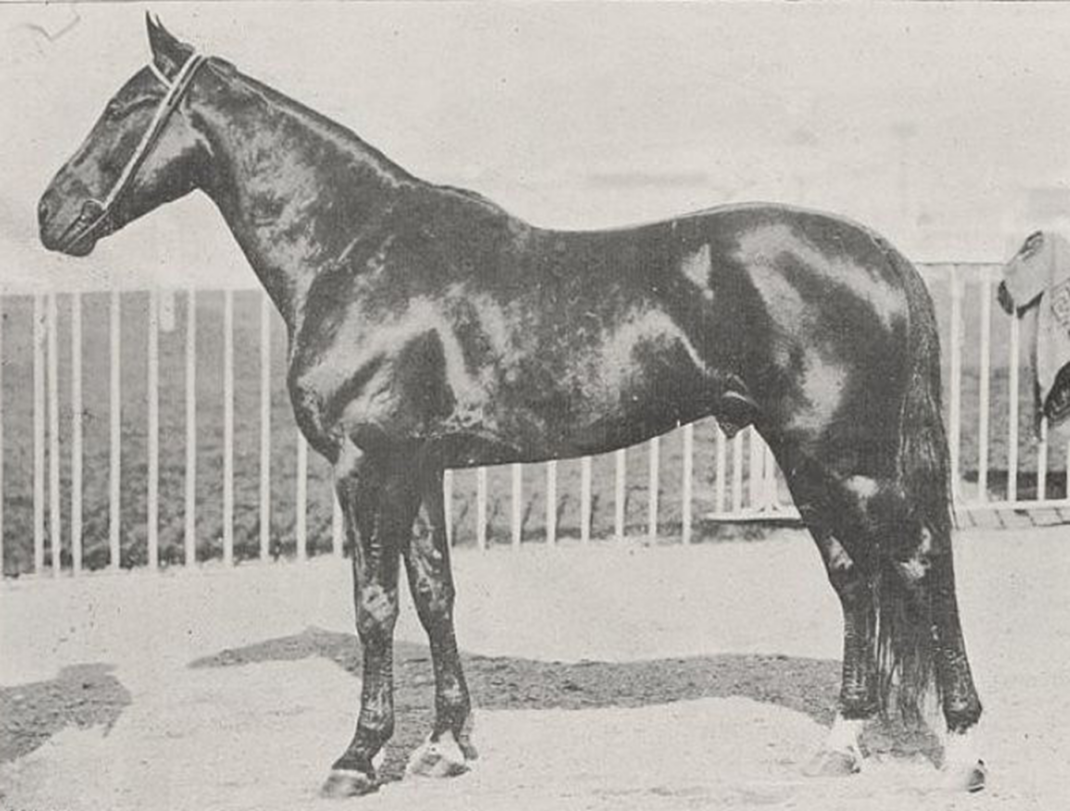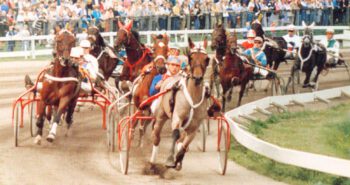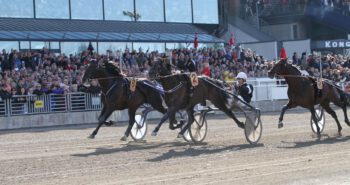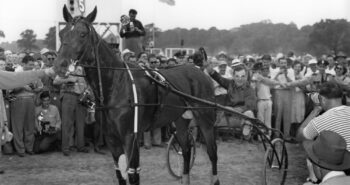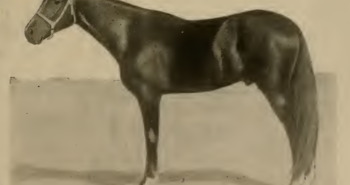The blue-blooded Kentuckian excelled in Europe, becoming the first horse to win an international race at Vincennes and later went on to be a stallion champion, siring the first European-bred 2:05 trotter and multiple Derby-winners.
Bred by Philemon Parrish, Wilburn M – for some reason only referred to as “Wilburn” is his short American career – was a daughter of Wilton and Rose Leyburn, herself a daughter of the legendary broodmare Mamie. Sold to the Bowerman brothers, Mike and George, the colt must have made a name for himself in training at 2. In late July 1894, the Frankfort Roundabout wrote that “the Lexington Fair, August 28 to September 1, offers an opportunity to see the very best racing this summer. Two races will be trotted each day. In the Agricultural Stake for two-year-olds, (…), the phenomenal Wilton colt, Wilburn, and others, will take the word.” However, come race day, Wilburn M did not start. As he wasn’t mentioned in newspapers reports one can only speculate as to why.
The colt was paid in to the Kentucky Futurity the following year and appeared on the list of starters, but again the horse was left out from the starting field by the Bowermans. Instead, he was taken to the State Fair in Columbus, Ohio, where he won the 2:33 class in three straight heats, winning in 2:27 1/4, 2:27 and 2:28 1/4 (1.31,5, 1.31,4 and 1.32,1). Then the colt was laid over until the following season, when he made his seasonal debut on July 8, 1896. Then he finished second to Isaac in the 2:20 trot at Lexington. Nine days later he got his first win, as he took home the 2:25 trot in 2:19 and 2:20 1/2 (1.26,4 and 1.27,3). On Jul 31, the Lexington Herald-Leader reported that “George Bowerman drove the bay horse Wilburn in 2:18 (1.25,8)” on the track there. However, Wilburn M only started once more in the US, in the 2:27 trot in Columbus in early August, where he finished among the last. Then he was off to Europe.
What happened is described in an article in the Detroit Free Press on Jul 31, 1910 where Wilburn M’s son Willy is given a lot of space, but where the story of his sire’s export is also told. “Mike Bowerman, who sold his sire Wilburn M for export, was talking about that horse. Mike said that he knew Wilburn was a great colt trotter, and one day he priced him to some foreigners for $2,000, but they bought something cheaper and went their way. At the Lexington station they met another bunch from across the water, and when asked about a good horse for racing and stock purposes they directed the visitors to Bowerman’s.
Mike showed the Wilburn M, then a 3-year-old, and priced him at $2,500. They kicken on the raise, but he said it would be $3,000 in a day or two, so they had better hurry. Wilburn was brought out and warmed up and shown to them at speed and for manners. Finally a young German asked, through the interpreter, to drive him, and Mike assented, telling the boy to score him down at a 3:00 clip, turn and come back at a 2:50, and on down to about a 2:20 (1.27), dropping ten seconds at a time. Then the last time come hiking and let him step the mile. The boy did it, Mike says he was a fine driver and the mile was in 2:16 (1.24,5). ‘Well,’ said Mike, ‘they couldn’t count the money out fast enough.’ (Note: This story was told in 1910 and Bowerman’s memory is demonstrably slightly off: Given that Wilburn M started in the US in 1896, the horse was four, not three, at the time of sale.)
A historic win at Vincennes
Imported to Germany by the Beermann brothers in 1896, Wilburn M’s quickly proved himself in Europe. In 1897 he was fourth in the Matadoren-Handicap in Baden in Austria. Some evidence suggest Wilburn M, despite being a 2:10 trotter, was more comfortable over longer distances. When Colonel Kuser won the Championship von Europa, at the time the most prestigious European race, in Baden on Aug 13, 1899, winning in 1.21,9 (2:11.4) over one mile, Wilburn M started in Sonntags-Rennen over 2800 meter (1 3/4 mile), winning comfortably in 1:26 (2:18.2), making up 80 meters (87 yards) on Princesse Nefta and 120 meters (131 yards) on St. Tanzy. Two days later, on the same track, he made up 160 meters (174 yards) on St Tansy in August-Rennen, winning in 1.25,7 over 2920 meter (2:17.4 over 1 13/16 mile). In 1900, Wilburn M went out against the elite in the Championship von Europa. He finished third in the first two heats, the first won by Caid ahead of Athanio, these two switched places in the second heat. In the third heat Caid won in a hard-fought duel with Wilburn M, both horses trotting the mile in 1.22,6 (2:13). The following year he took third place in the first heat and fifth in the second.
The highlight of his career came at Vincennes on Oct 23, 1899. On this day the Paris racetrack hosted the first race designated as an “international race”, though there had been foreign starters and winners there prior to this. In the race simply named “International de Vincennes”, Wilburn M, driven by a “C Danon”, beat the French hosts and several foreigners over 4000 meters (roughly 2 1/2 mile), trotting the distance in an absolute time of 6:09 1/5, a kilometer time of 1.32,3 and a mile time rate of 2:28 1/2. The French thought the distance of 4000 meters was way too long for the US-bred horses, but the first finishers were all American-born: Wilburn M, Deck Miller, Charming Chimes and Killona. Vincennes at the time was more demanding than today: it was a slower track with a more demanding uphill – but again, this all further suggests that Wilburn M was right at home in longer and more races.
An excellent stallion
In 1899, Wilburn M was sold to Julius Morgenstern and S Ruzicka. The colt stood stud first in Vienna, then in Szombathely, Hungary, until he was sold to Count Leonid Vyazemsky in Russia, in late 1904 or early 1905. Wilburn M excelled at stud. In Austria he sired the excellent Willy, who was later taken to the US where he won several races on the Grand Circuit and took a magnificent 2:05 (1.17,7) record in 1911.
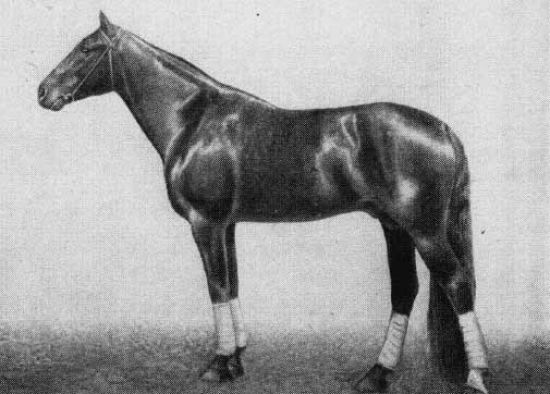
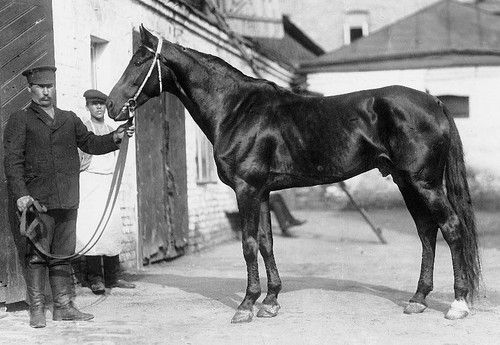
Wilburn M then proved a very good stallion in the land of the Czar as well. In his first Russian crop he sired Tsenturion, winner of the 1910 Russian Trotting Derby. His last known foal in Russia was Iarmarka born 1914. It’s unknown how long Wilburn M lived, but most trotting stock in Russia was killed in the first World War. When Will Caton later spoke of American trotters who survived this devastating period in Russia he never mentioned Wilburn M – and for these two reasons it’s safe to conclude that he died sometime between 1913 and 1918.
Wilburn m
Bay colt born in Midway, KY in 1892. Died in Russia sometime during WW I.
Wilton – Rose Leyburn (Onward)
1.21,9 (2:11.4)
Breeder: Philemon Parrish
Owners: Philemon Parrish – Bowerman brothers – Beerman brothers, Germany – Julius Morgenstern and S Ruzicka, Austria – Count Leonid Wyazemsky, Russia
Trainers: George Bowerman and others
Drivers: George Bowerman, C Danon and others
Groom: –

